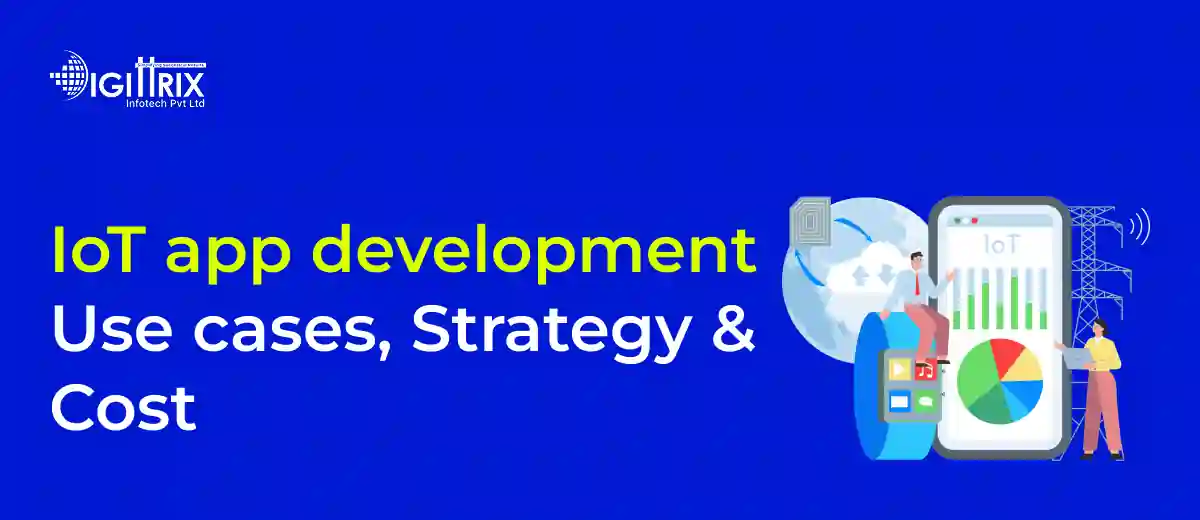IoT applications are growing fast, impacting healthcare, logistics, manufacturing, and daily life. Businesses worldwide invest heavily, with the global IoT market expected to cross trillions by 2030.
Highlights
With Over 14 years of Experience in the IT Field, Helping Companies Optimise there Products for more Conversions

The Internet of Things (IoT) has transformed how people and businesses interact with technology. With billions of devices connected worldwide, IoT is no longer just about smart homes or fitness trackers. It is now used in healthcare, manufacturing, logistics, agriculture, and even urban development. At the core of this change is IoT app development, where mobile and web applications are designed to connect, control, and analyze IoT devices.
This article explores the most common use cases for IoT apps, the best strategy for building them, and the overall costs involved. It also explores how businesses and individuals can approach custom app development for IoT projects virtually.
Concerned about data breaches? Check Digittrix's simple security tips to protect your business!
IoT app development involves building software applications that connect to IoT-enabled devices, collect data, and let users monitor or control them remotely. For example, an IoT mobile app can enable a user to turn off lights, track a delivery truck, or check the temperature of industrial supplies. Different typical apps and IoT applications are directly connected to physical devices and sensors. They need to process real-time data, stay connected constantly, and support various hardware types. This requires a different strategy from traditional mobile app development services.
IoT apps are now found in almost every industry. Here are some detailed use cases:
One of the most common applications of IoT is home automation. People can control lighting, heating, and security systems using an IoT mobile app. Examples include energy monitoring, smart locks, and voice-controlled assistants.
In healthcare, IoT is used for patient monitoring through wearable devices, connected equipment, and hospital management systems. Doctors can monitor patient vitals in real-time and receive alerts if something unusual occurs. This improves treatment and allows for quick emergency responses.
Manufacturers use IoT apps to monitor machinery, predict maintenance needs, and boost productivity. For example, sensors can detect when a machine might fail, and the app alerts the team in advance, reducing downtime and costs.
Fleet managers use IoT apps to track vehicles, monitor fuel use, and keep deliveries on schedule. A logistics company might rely on on-demand app development to create a system that provides real-time shipment location updates.
IoT apps can monitor soil quality, water levels, and crop health. Farmers can control irrigation systems remotely with a smartphone app. This makes agriculture more data-driven and boosts crop yields.
Retailers leverage IoT to enhance customer experience and oversee supply chains. Smart shelves and connected systems support inventory management. Customers can also get instant product details via connected apps.
Governments are investing in IoT to develop smart cities. Applications include traffic management systems, waste disposal, and connected streetlights. These technologies enhance urban living by making it more efficient and sustainable.
Building an IoT application requires a clear strategy. Here are the steps companies and individuals should follow when working with an IoT app development company or developing in-house.
Before you begin, it’s important to understand the specific problem the app will solve. Is it for home users, healthcare providers, manufacturers, or retailers? Having a clear goal helps in defining the right features and budget.
Not all IoT devices function the same way. Developers need to decide if the app will connect with smart sensors, wearables, or industrial equipment. Making sure it works with different devices and operating systems is important.
IoT apps handle sensitive data. A healthcare app manages patient records, while a smart home app controls door locks. Security features such as encryption, authentication, and secure APIs are essential.
Since IoT apps need expertise in both hardware and software, it's crucial to select an experienced IoT app development company or hire skilled mobile app developers.
IoT systems often begin small but can grow quickly. For example, a factory might start with 20 connected machines and later add 200. The app must scale smoothly without performance issues.
The success of an IoT app often depends on its interface. A good IoT mobile app should be straightforward, easy to navigate, and responsive across different devices.
IoT applications must undergo thorough testing to handle real-world scenarios. After testing, they are deployed to users with regular updates planned.
The cost of IoT app development varies significantly depending on complexity, features, and connected device types. Here are the key factors influencing the cost:
A basic smart home app usually costs less than a large industrial IoT system. The number of devices connected directly impacts the budget.
Features like push notifications, data analytics, AI integration, or cloud support raise costs. Basic apps cost less, whereas apps with advanced features need more resources.
Building apps for both Android and iOS demands extra effort. Cross-platform development can save costs, but still needs thorough testing.
Since IoT apps require strong security, additional investment is made in encryption, authentication, and compliance. This increases the cost but remains essential.
Hiring developers in North America or Europe is typically more costly than in Asia. Businesses might partner with an IoT app development company in regions that provide more competitive prices.
Once developed, IoT apps need regular updates, bug fixes, and support. Ongoing costs can amount to 15–20% of the initial development budget each year.
If the app requires integration with other platforms like ERP, CRM, or cloud storage, there will be additional costs.
These figures are estimates. Actual costs vary depending on scope, timeline, and the complexity of requirements. Businesses might also invest in custom app development to meet their specific goals.
The demand for IoT applications is growing because they bring measurable benefits:
This is why numerous companies are investing in mobile app development services that target IoT projects.
While IoT apps are valuable, they come with challenges that businesses must be ready to face:
The future of IoT looks very promising. With improvements in 5G, AI, and edge computing, IoT applications will become faster, smarter, and more accessible. We will see more custom app development focused on sectors like healthcare, smart cities, and retail. For businesses, the question isn't whether to adopt IoT but how quickly they can do it. Partnering with an experienced IoT app development company can help organizations develop applications that deliver long-term value.
Looking for the right IoT development partner? Check Digittrix's guide to choosing the best IoT development company for your business!
IoT app development is revolutionizing industries by connecting devices, analyzing data, and giving users control over their environments. From smart homes and healthcare to logistics and agriculture, the possibilities are endless. Businesses planning to adopt IoT should start with a clear strategy, prioritize security, and assemble the right team. While the cost of developing an IoT app can vary, the long-term benefits are significant. Whether through on-demand app development or larger enterprise projects, IoT is expected to continue growing in the coming years.
For those aiming to create an IoT mobile app, selecting the right mobile app development services is crucial. Working with a specialized IoT app development company guarantees the project meets expectations and supports future expansion.
In 2025, connected applications are transforming industries worldwide, from smart homes and healthcare to logistics, agriculture, and manufacturing. Developing an IoT app helps businesses manage devices, process real-time data, and improve efficiency. Whether you’re launching a new product or growing your existing system, the right app strategy makes all the difference.
At Digittrix, a trusted web and mobile app development company, we specialize in creating IoT applications tailored to your business needs. With over 14 years of experience, our team provides secure, scalable, and user-friendly apps for startups, SMEs, and large enterprises. From mobile apps that control everyday devices to cloud-based dashboards for managing industrial sensors, we create solutions that deliver real value.Our approach guarantees intuitive interfaces, robust data security, and applications that can expand with your business.
If you're ready to build a future-proof IoT application aligned with your industry goals, contact Digittrix at +91 8727000867 or email digittrix@gmail.com. We help transform IoT ideas into functional systems that connect people, devices, and data.

Do you need help in Mobile App development?




Join over 1500+ businesses we've already helped!
Beauty App Development: Tips to Grow Your Business Through an App & Cost in India (2026)
They are software that connect with smart devices and sensors, enabling users to monitor, control, and analyze data in real time.
Costs vary based on features, complexity, and team location. Simple apps may start at $30,000, while large enterprise projects can go over $100,000.
They are widely employed in healthcare, manufacturing, transportation, retail, agriculture, and smart cities.
They offer convenience, increase efficiency, minimize downtime, and enable better decision-making through real-time data.
Key challenges include security vulnerabilities, device compatibility problems, data overload, and the necessity for regular updates.

©2026Digittrix Infotech Private Limited , All rights reserved.